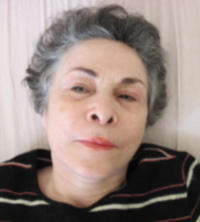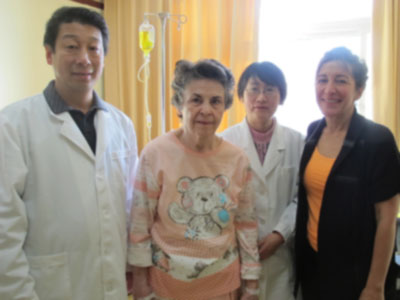Mahshid Ardehali - Parkinson syndrome (Iran) Poated on January 7, 2013
Name: Mahshid Ardehali 
Sex: Female
Country: Iran
Age: 70
Diagnoses: 1. Parkinson syndrome, 2. Urinary infection
Admission Date: December 5, 2012
Days Admitted to Hospital: 28 days
Before treatment:
Mahshid Ardehali has suffered from bradykinesia for the past 8 years. She also had problems with facial expression. She didn't receive any therapy. She suffered from tremors in both upper limbs; stiffness in both lower limbs and the bradykinesia was aggravated. She went to a local hospital and was diagnosed with Parkinson syndrome. She started to take levodopa, an incremental dose to control her symptoms. The tremor, myotonia and bradykinesia, were aggravated gradually over time. The local doctor gave her Sifrol tablets, levodopa and Entacapone for combination therapy. The tremor of both upper limbs became alleviated. The patient's disease progressed gradually. The patient suffered from walking difficulty and equilibrium disorder. She had frequent urination and urgency of urination starting around 2 years ago. At present, the patient has difficulty with walking. She also has poor activity endurance. With some assistance, the patient can walk only short distances. She also has equilibrium disorder.
Admission PE:
Bp: 139/83mmHg; Hr: 72/min. Br: 20/min. The nutrition was normal. She arches her back when she walks. The gait presented is limp with small steps. She needs some assistance with walking. She has poor balance ability. She is liable to fall down when she walks without any assistance. Her bilateral hip joints, to rear thigh and ankles, have obvious pain after a little exercise. The pain in the left side was more obvious. The pain was alleviated after a rest while lying on her back. She often has illusions and looks far ahead. She mistakes her daughter with others. She has grope symptoms in the afternoon. There were protruding red papules in the skin around elbow joint. The red papules had obvious pruritus. There was no congestion in the pharyngeal. There was no enlargement of the tonsils. The respiration of both lungs was clear, with no dry or moist rales. Through auscultation, it was determined that the heart sounds were strong, with no obvious murmur in valves. Through palpation, the abdomen was found to be soft, with no pressing pain or rebound tenderness. There were no masses touched. The liver and spleen were not touched. There was no swelling in the lower limbs. Urine routine: WBC was full of visual field.
Nervous System Examination:
Mahshid Ardehali was alert, but her speech was slightly ambiguous. The memory, calculation abilities, and orientation were normal. She had a masked face. Both pupils were equal in size and round, the diameter was about 3.0mms. The movement of both eyeballs were flexible and both pupils were sensitive to light stimuli. The forehead wrinkle pattern and nasolabial groove were symmetrical. The tongue was centered in the oral cavity and there was no muscular tremor of the tongue. The muscles that raise the soft palate were strong. She could swivel her head slowly. The movement of the body was slow. This was accompanied with tremor of hand. The tremor of the third finger in the left hand was obvious. When she is focusing attention, the trunk and lower limbs had an obvious twist. The muscle strength of shrug left shoulder was level 5-, the muscle strength of shrug right shoulder was level 5. The muscle strength of left upper limb was level 5-. The muscle strength of right upper limb was level 5, the muscle strength of both lower limbs was level 5-. She had slight difficulty with starting the process of walking and she walked slower than normal. Her back arches obviously when she walks. She turns around slowly, which she needed five steps to do and her gait was unstable. She had a pattern of falling down when she walk without assistance. The muscle tone of the four limbs was slightly higher than normal. The tendon reflex of both upper limbs was normal. Right patellar tendon reflex was normal. Left patellar tendon reflex was not slowed down. Bilateral Achilles tendon reflex and abdominal reflexes were normal. Left Hoffmann sign was positive. Bilateral Babinski sign was negative. There was normal fine, deep, and shallow sensation. The bilateral finger-to-nose test was slow. Right side did digital opposition test slowly and on the left side she could only point her thumb with forefinger and middle finger. She was able to complete the rapid rotation test flexibly. She was able to complete the heel-knee-shin test in a stable manner. The Romberg sign was positive. The meningeal irritation was negative.
Treatment:
Mahshid Ardehali received treatment starting on December 5, 2012. She received nerve regeneration, neural repair, anti-Parkinson's treatment and brain protection. She was also given treatment in order to expand the blood vessels, nourishment for the neurons and control urinary infection. This was combined with physical rehabilitation training and language training.
Post-Treatment:
At present, the patient's blood pressure is more stable than before. The blood pressure fluctuation is between 100/80mmHg -135/90mmHg. The patient's mental status has improved. The masked face is not so severe. She is able to smile. The articulation is clearer than before. The muscle strength of neck and four limbs are level 5. The muscle tone is normal. The walking gait has improved. The arching position, festinating gait and shuffling gait are not so severe. She walks independently. She has better balance ability. She has no pattern of falling down. There is no obvious tremor in both hands. The Bradykinesia of limbs is not so severe. The starting difficulty is alleviated. She can do the digital opposition more flexibly. The pain of bilateral hip joints, rear thigh and knee joints after exercises are obviously alleviated. There is no involuntary twist. The delusions and grope symptoms are alleviated. The protruding red papule in the skin around the elbow joint has disappeared. The pruritus has disappeared. The urine routine has been restored to normal. The patient's condition is stable.

Date: 2013-05-22
Report Mrs. Mahshid Ardehali May 2013
Dear Dr. Zhao,
I have just spent one month in Iran with my mother and had the opportunity to see how she is doing and what has changed since the stem cell treatment she went through.
We have not changed the dosage of the antidepressant as her mood is good at the moment, however we have progressively tapered down the lorazepam to 1mg. Since then, she has felt less tired and less confused in the morning.
It seems that when her first sinemet is taken early in the morning (around 6am) her legs unlock around 8-9am and she is able to walk better.
Her delirium and confusion symptoms have improved a lot and she barely has any after taking her sinemet. Her hands' resting tremor has almost completely disappeared as well as her upper body dyskinesia. In general, her only problem remains her balance (+painful knees) and especially her right leg that does not respond thus not allowing her to walk properly. Her sleep has improved a lot and she has less confusion upon awakening. However, she sometimes suffers from headaches that usually occur when her blood pressure drops very low, do you believe it is still necessary for her to take her blood pressure medicine? (please find attached her BP results for the last 2 weeks)
Some important information: For the past week, there has been a sudden enormous improvement in my mother's condition. She is a lot more reactive and conscious, she has been walking without her crutches, cooking and eating things that she has not for a long time. We are not sure what made her improve so much suddenly, do you thing it is the stem cells being activated?
(Download the Windows Media Player Firefox Plugin if you are using Firefox browser.
To know more,Please read Using the Windows Media Player plugin with Firefox.)
